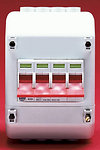- Joined
- 27 Jan 2008
- Messages
- 27,475
- Reaction score
- 3,323
- Location
- Llanfair Caereinion, Nr Welshpool
- Country

There are many ways to start a three phase motor.
1) Direct on line.
2) Star/Delta
3) Auto transformer
4) Resistor
5) Soft start
6) Inverter
The starting method alters how fast it starts, what start current it takes, and torque on the shaft, your questions will have different answers depending on start method, also with a compressor we look as de-loading, again different methods are used.
I had a small compressor at work part of a batching plant, it would blow the fuses, we had done all the normally tests and could find no electrical fault, the fitters could not find a mechanical fault, so since I had electrical and mechanical training I was sent to watch it, to see if I could find the fault, it ran all morning no problem, then not much concrete needed in afternoon so it was idle for a long time, then I saw the drive pulley turn a little, and it clicked as to fault, the star/delta starter in star opened a air solenoid which if there was air in the tank opened the inlet valve so the compressor has very little load, however the exhaust valve was leaking, so it would turn the crank until bottom dead centre, then fill cylinder with air, as a result the solenoid could not open the inlet valve as too much pressure, so compressor trying to start on load.
The cure was a normally open solenoid instead of normally closed, and wired to delta so all the time the compressor was idle the inlet valve was open, so no air pressure could build up, what was really annoying was rather than a pat on the back from fitters at saving them stripping down the compressor and lapping in valves, they said there you are we told you it was an electric problem.
However this interlinking between the starting system and compressor makes it hard to alter start methods, and also hard to work out start current, in the main it was a clip on ammeter and actually measure, as volt drop can alter time needed to start, in latter years there was a move to screw compressors which have a completely different set of problems.
But it is a case fools rush in where angles fear to tread, so on a forum I would not attempt to say how to wire a compressor be it single or three phase, there are so many variables. I don't think I have seen direct on line used with compressors, but seen most of the other options.
1) Direct on line.
2) Star/Delta
3) Auto transformer
4) Resistor
5) Soft start
6) Inverter
The starting method alters how fast it starts, what start current it takes, and torque on the shaft, your questions will have different answers depending on start method, also with a compressor we look as de-loading, again different methods are used.
I had a small compressor at work part of a batching plant, it would blow the fuses, we had done all the normally tests and could find no electrical fault, the fitters could not find a mechanical fault, so since I had electrical and mechanical training I was sent to watch it, to see if I could find the fault, it ran all morning no problem, then not much concrete needed in afternoon so it was idle for a long time, then I saw the drive pulley turn a little, and it clicked as to fault, the star/delta starter in star opened a air solenoid which if there was air in the tank opened the inlet valve so the compressor has very little load, however the exhaust valve was leaking, so it would turn the crank until bottom dead centre, then fill cylinder with air, as a result the solenoid could not open the inlet valve as too much pressure, so compressor trying to start on load.
The cure was a normally open solenoid instead of normally closed, and wired to delta so all the time the compressor was idle the inlet valve was open, so no air pressure could build up, what was really annoying was rather than a pat on the back from fitters at saving them stripping down the compressor and lapping in valves, they said there you are we told you it was an electric problem.
However this interlinking between the starting system and compressor makes it hard to alter start methods, and also hard to work out start current, in the main it was a clip on ammeter and actually measure, as volt drop can alter time needed to start, in latter years there was a move to screw compressors which have a completely different set of problems.
But it is a case fools rush in where angles fear to tread, so on a forum I would not attempt to say how to wire a compressor be it single or three phase, there are so many variables. I don't think I have seen direct on line used with compressors, but seen most of the other options.

